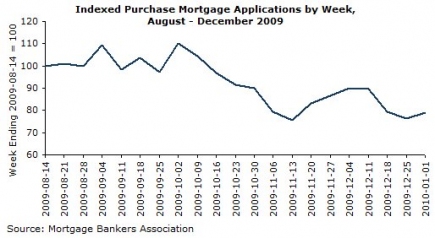January 06, 2010
January 6, 2010 (Housing Market Monitor)
By Dean Baker
Pending home sales in the Northeast and Midwest were down 25.7 percent.
The National Association of Realtors reported that pending home sales fell 16.0 percent in November, hitting their lowest level since June. Remarkably, this decline appeared to surprise many analysts. It should have been entirely predictable.
In the prior three months, there had been a sharp surge in home sales. This surge was obviously driven by the desire to close on a sale before the expiration of the original first-time buyers tax credit at the end of November. Because it depended on the closing date of a sale, buyers had to sign contracts by mid-October to ensure that they would qualify for the credit. This was before they knew that the credit would be extended.
This created a situation in which many people who would have otherwise purchased their home in 2010, or possibly even 2011, moved their purchase forward to take advantage of the credit. The pending home sales index for October, as well as the existing home sales for November (which reports closings, not contracts), hit their highest levels since 2006, at the peak of the bubble.

The collapse of sales was also foretold by a plunge in purchase mortgage applications in late October and November. People who sign contracts apply for mortgages. When the weekly applications numbers collapsed, hitting their lowest level since the late 90s, it should have been apparent that house sales would fall sharply.
In fact, the decline is likely even worse than the national data may indicate. There were sharp differences by region. While sales in the South were down 15.0 percent, roughly in line with the national average, sales in both the Northeast and Midwest were down 25.7 percent. The November level for the Midwest was the lowest for the year. These sharp plunges were offset by a relatively modest 2.7 percent decline in the West.
Part of the story in the West is that sales peaked in September (October numbers were down by 10.9 percent), but it is also likely that there is a different dynamic taking hold. With prices down by 50 percent or more in some of the former bubble markets, there are likely many investors moving in to buy large numbers of homes. This is helping to place a bottom on these markets.
While this is good news for the West, there is likely to be considerably more weakness in the rest of the country than is generally recognized. This will be amplified in the months ahead as mortgage interest rates rise due to the end of the Fed’s mortgage-backed security purchase program. The curtailing of FHA loans will also reduce the number of potential homebuyers. And the ending of the extended homebuyers credit at the end of April will further reduce demand. (The new credit is tied to the signing of the contract rather than the closing of the sale, so it should lead to some boost in sales into May and June.) This weakness virtually ensures that the house price decline will resume somewhere in the next few months, even if we do not get back into the free fall seen last year.
The more newsworthy report this week was the release of construction data showing that both residential and non-residential construction fell in November. Residential construction fell 1.6 percent, which partially reversed an extraordinary jump in October. Private non-residential construction was down only minimally, but the October data was revised down to show a 4.8 percent drop. The November level was 20.6 percent lower than the year ago level.
All the components of the non-residential index are now below their year ago level, most sharply lower, with the exception of power plants. The boom in bio-fuels, that had supported construction of manufacturing facilities, is over and this component is now dropping sharply, off 13.1 percent from its July level. Public construction also edged downward in November, suggesting the boom associated with the stimulus might have reached its peak. While residential construction is likely to be reasonably stable at low levels in 2010, non-residential construction will be a drag on economic growth.
Dean Baker is Co-Director of the Center for Economic and Policy Research, in Washington, D.C. CEPR’s Housing Market Monitor is published weekly and provides an incisive breakdown of the latest indicators and developments in the housing sector.






